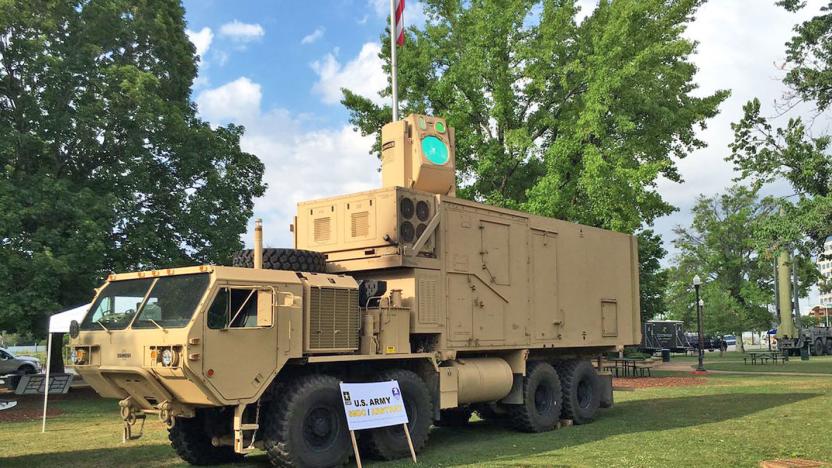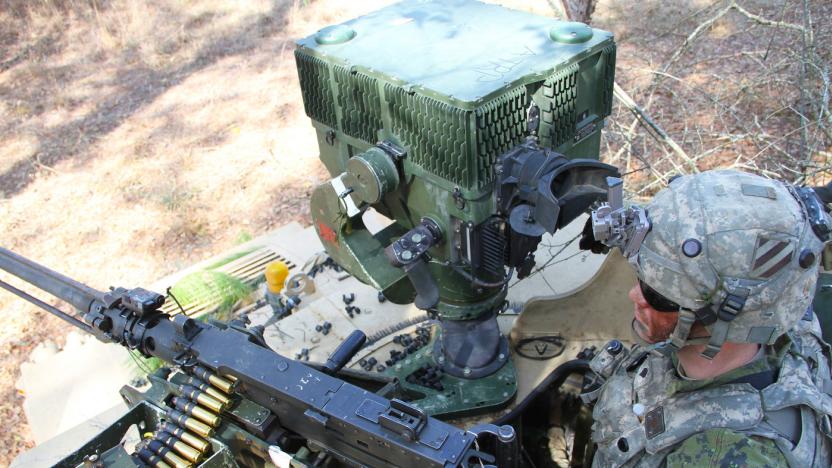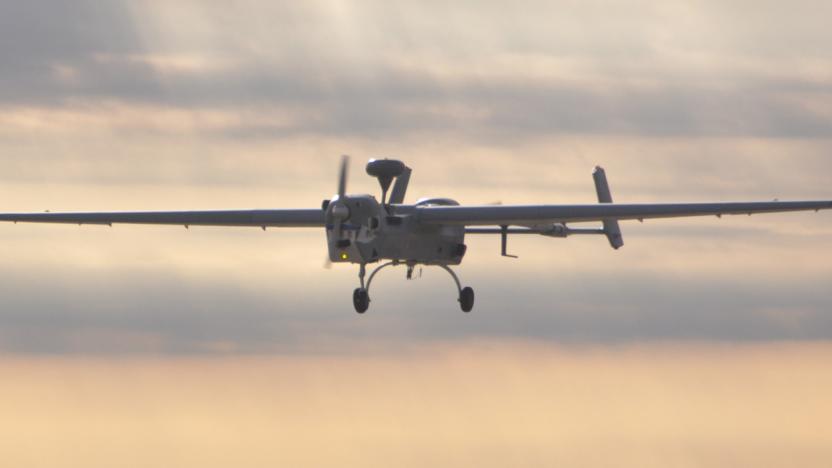Army
Latest

US Army wants helicopters to refuel at robotic pumps
Militaries regularly set up fueling stations at forward bases so that helicopters can get back to the fight as quickly as possible. However, requiring fuel crews creates huge risks and logistical headaches: you're sending people to a dangerous, isolated section of the battlefield for a fairly mundane role. Thankfully, the US Army might not need to take that risk for much longer. It's testing an unmanned station, the Autonomous & Robotic Remote Refueling Point (AR3P for short), that can top up a helicopter with no human involvement. Much like Tesla's robotic charger, it would use self-aligning, articulated arms to hook a fuel line to a helicopter all by itself. That, in turn, would let helicopters fly at all hours without putting footsoldiers in harm's way, and would likely refuel them faster.

US Army expects to take down planes with anti-air lasers
Forget shooting down drones with vehicle-mounted lasers -- the US Army is ready to take on the bigger machines. Space and Missile Defense Command chief Lt. Gen James Dickenson has revealed that the Army is preparing lasers that are ten times more powerful than the ones in testing now, at between 50kW to 100kW. That kind of wattage is strong enough to take down aircraft, and might even throw missiles off their targets by confusing their sensors. They won't necessarily require gigantic trucks like they do today, either.

US Cyber Command may be splitting off from the NSA
It sounds as though the United States' Cyber Command will break off from the National Security Agency and be more aligned with the military in the future. The move would "eventually" cleave Cyber Command from the intelligence-focused NSA and instead align it more with the military, according to the Associated Press. "The goal is to give Cyber Command more autonomy, freeing it from any constraints that stem from working alongside the NSA," AP reports. The NSA's core task of intelligence gathering sometimes is at odds with military cyber warfare operations, hence the proposed separation. Prior to this, the two had clashed on getting intel from Islamic State networks (the NSA's task) and attacking (Cyber Command's).

US Army is building a versatile, flying squirrel-like drone
The military is constantly working on new drone technology. That includes new types of drones like autonomous boats and small swarming UAVs as well as ways to combat drones, like frying them with microwaves, guided bullets and hacking. Right now, the US Army is working on a small, lightweight drone that can take on a number of tasks depending on what's needed in a given situation.

Air Force enlists hackers to hunt bugs in its site
Bug bounties have been a staple among startups and online businesses since the days of Netscape Navigator but the federal government has been slow to adopt the beneficial code hunts. However, a year after the DoD's first such program, Hack The Pentagon, the Air Force announced on Wednesday that it will be hosting one of its own next month.

Toy drones don't stand a chance against a $3 million missile
A Patriot missile costs around $3 million. A commercial quadcopter? Let's say roughly $200. But which one would win on the battlefield? General David Perkins, Commander of the US Army Training and Doctrine Command, knows the answer to this hypothetical David and Goliath match-up -- because it's already happened. During a military symposium, he touched on a strike made by a US ally, where the consumer drone "did not stand a chance" against the twenty-year old missile. With all due respect, sir, we could have told you that.

ICYMI: The U.S. Army is making actual hover bikes
try{document.getElementById("aol-cms-player-1").style.display="none";}catch(e){}Today on In Case You Missed It: The Galactic Empire will have some competition for Speeder Bikes soon enough, from the US Army. Researchers there have been working on hoverbikes for a few years now, based on an Australian inventor's design. Make sure to watch the video of the temperatures stacking up each year, bringing us to the hottest recorded weather for 2016, or a video of the sunspot twice as big as Earth. As always, please share any interesting tech or science videos you find by using the #ICYMI hashtag on Twitter for @mskerryd.

Apache helicopters now have real-time drone vision
After 30 years in service, the Army's AH–64E Apache attack helicopters now have the ability to fly with an unmanned wingman. A new system called Manned-Unmanned Teaming (or MUM-T) allows Apache flight crews to tap into the real-time video feeds, sensors and control systems of nearby Army Shadow and Grey Eagle drones. According to Scout Warrior, the system is already being used in Afghanistan.

US Army's smart earplugs spare soldiers from loud noises
As you might imagine, soldiers can't just use garden variety earplugs to protect their ears. It might tone down the sounds of explosions and gunshots, but it'll also prevent them from hearing a crucial command or an enemy on the other side of a doorway. It's less of an issue for the US Army these days, though. The military branch has been gradually rolling out a smart earplug, TCAPS (Tactical Communication and Protective System), that adapts to the audio realities of war. The smartphone-linked device softens louder noises, but amplifies quieter ones; if your squad leader needs to issue a command, you'll hear it over the din of battle.

ICYMI: How to banish drones, fast levitating train and more
#fivemin-widget-blogsmith-image-150144{display:none;} .cke_show_borders #fivemin-widget-blogsmith-image-150144, #postcontentcontainer #fivemin-widget-blogsmith-image-150144{width:570px;display:block;} try{document.getElementById("fivemin-widget-blogsmith-image-150144").style.display="none";}catch(e){} Today on In Case You Missed It: A startup plans to detect and disable any drone flying within range of its proprietary system with a planned launch date later this year. The US Air Force beat its own magnetic levitation speed record at 633 miles per hour. Researchers developed e-skin that can track blood oxygen content and heart rate, displaying on LEDs. We are smitten with this commuter bike car from Sweden so please check it out. As always, please share any great tech or science videos you find by using the #ICYMI hashtag on Twitter for @mskerryd.

US Army hopes to outfit soldiers with tiny drones by 2018
American soldiers should soon get drone support beyond just big, expensive machines flying well above the battlefield. The US Army has requested industry information on the feasibility of making tiny drones (Soldier Borne Sensors in official lingo) that would help infantry gather intelligence on a small scale, such as peeping over a hill or around a building. Its dream recon machine would weigh no more than a third of a pound, launch within one minute and fly for at least 15 minutes. Ideally, the drones would be in service as soon as 2018.

US Army turns to phone app to prevent base attacks
Neighborhood watch apps aren't just for civilian streets. The US Army has forged a deal with CloseWatch to use a mobile crime reporting app, iWatch Army, to prevent mass shootings and other crimes at over 20 domestic bases. The software forwards tips (based on the FBI's own crime codes) to the appropriate unit in less than 8 seconds, or faster than a 911 call. It also has its own notifications, so you can get an alert if there's a credible threat. While iWatch Army isn't meant to replace emergency services, it could be crucial to catching terrorists before they're ready to strike.

US Army patents bullet that self-destructs to protect civilians
The .50 caliber bullet is one of the biggest projectiles you can fit in a rifle or machine gun. Its size and range makes it super-effective at neutralizing foes over long distances, but because it also takes a lot to stop, it can still harm or kill innocent bystanders. Maybe that's why the US Army has patented a new "limited range projectile" that self-destructs as it reaches its target.

Helicopter and six-wheeler make a mean, crewless recon team
Why send humans into dangerous territory when you can send unmanned helicopters and six-wheelers instead? In an impressive mashup of autonomous transportation, Carnegie Mellon University (CMU) and aircraft manufacturer Sikorsky have shown the two vehicles working together without on-board operators. During the demonstration, a modified Black Hawk helicopter picks up a chunky Land Tamer with a large cage, before flying 12 miles and releasing it at a designated drop-zone. The ground vehicle then navigates the leafy terrain for six miles, with a remote driver occasionally chipping in to explore particularly hazardous sites.

Government testing smart parachutes that stay on target
GPS is not foolproof -- especially on the modern battlefield, where electronic warfare systems can interfere with the satellite guidance. And when packages miss their mark, soldiers often have to venture into hostile territory to retrieve them. That's why the US Army is developing a joint precision airdrop system, or JPADS, that guides equipment towards its target using only visual cues.

US Army retires its first drone
Military drones may still seem like relatively fresh concepts, but they're officially old hat as of this month: the US Army has retired its first-ever drone, IAI's Hunter, after 20 (!) years of service. The robotic recon veteran will now see use only through government-owned contractor support units. The troops, meanwhile, will upgrade to the General Atomics Gray Eagle, which boasts better sensors on top of greater endurance (25 hours instead of 12) and a higher altitude ceiling (29,000 feet versus 15,000).

ICYMI: Smartest lights yet, robots on the farm and more
#fivemin-widget-blogsmith-image-433187{display:none;} .cke_show_borders #fivemin-widget-blogsmith-image-433187, #postcontentcontainer #fivemin-widget-blogsmith-image-433187{width:570px;display:block;}try{document.getElementById("fivemin-widget-blogsmith-image-433187").style.display="none";}catch(e){}Today on In Case You Missed It: BeOn Home has made smart lightbulbs that recognize noises like a doorbell or fire alarm and turn on accordingly. A robot designed to check fertilizer levels and smash weeds should help the average family farmer one day. And the US Army is checking its soldier's brain waves to understand what part of an image captures their attention.

Runaway blimp prompts the US to freeze a missile defense program
That US Army radar blimp that ran amok didn't just trigger an internet frenzy... it may have put the brakes on a big military research initiative. Pentagon officials have frozen the JLENS (Joint Land Attack Cruise Missile Defense Elevated Netted Sensor System) program behind the blimp while they investigate what went wrong. The government isn't saying what it might do, but there are already politicians calling for the blimps to be cut. JLENS had already been hanging by a thread ever since 2010, when the Army threatened to kill it -- there are longstanding concerns about both the technology's reliability and its effectiveness compared to conventional aircraft. Don't be surprised if these defensive dirigibles vanish in short order. [Image credit: U.S. Air Force/Tiffany DeNault via Getty Images]

The US Army lost control of a radar blimp
It's the runaway llamas all over again... in airborne form. One of the US Army's missile-detecting radar blimps broke off its tether in Maryland, creating havoc both in the skies (the Air Force even sent fighter jets to track it) and among the many, many internet users following its every move. It eventually drifted over Pennsylvania, and there are reports that it knocked out power lines at a school in the state before coming down. We're still waiting to know the blimp's health, but it's safe to say that the Army will be more than a little red-faced as it looks into what went wrong.

ICYMI: Latest grenade launcher, modular smart watch and more
#fivemin-widget-blogsmith-image-332561{display:none;} .cke_show_borders #fivemin-widget-blogsmith-image-332561, #postcontentcontainer #fivemin-widget-blogsmith-image-332561{width:570px;display:block;} try{document.getElementById("fivemin-widget-blogsmith-image-332561").style.display="none";}catch(e){}Today on In Case You Missed It: The U.S. Army is more interested than ever in blowing things up with precision, and that's why it's beginning acceptance testing on a smart grenade launcher that can detonate explosives mid-air. The rest of us can get our geek on with the Kickstarter for Blocks modular watch, which has different modules for all kinds of things: Advanced fitness tracking, mobile payments or GPS. And a Kickstarter to house jellyfish in the fanciest way possible is up for a hefty $1,500.







